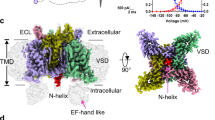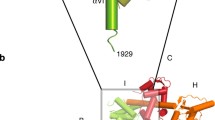Abstract
The mechanism of inactivation of mammalian voltage-gated Na+ channels involves transient interactions between intracellular domains resulting in direct pore occlusion by the IFM motif and concomitant extracellular interactions with the β1 subunit. Navβ1 subunits constitute single-pass transmembrane proteins that form protein–protein associations with pore-forming α subunits to allosterically modulate the Na+ influx into the cell during the action potential of every excitable cell in vertebrates. Here, we explored the role of the intracellular IFM motif of rNav1.4 (skeletal muscle isoform of the rat Na+ channel) on the α-β1 functional interaction and showed for the first time that the modulation of β1 is independent of the IFM motif. We found that: (1) Nav1.4 channels that lack the IFM inactivation particle can undergo a “C-type-like inactivation” albeit in an ultraslow gating mode; (2) β1 can significantly accelerate the inactivation of Nav1.4 channels in the absence of the IFM motif. Previously, we identified two residues (T109 and N110) on the β1 subunit that disrupt the α-β1 allosteric modulation. We further characterized the electrophysiological effects of the double alanine substitution of these residues demonstrating that it decelerates inactivation and recovery from inactivation, abolishes the modulation of steady-state inactivation and induces a current rundown upon repetitive stimulation, thus causing a general loss of function. Our results contribute to delineating the process of the mammalian Na+ channel inactivation. These findings may be relevant to the design of pharmacological strategies, targeting β subunits to treat pathologies associated to Na+ current dysfunction.






Similar content being viewed by others
References
Armstrong CM, Bezanilla F (1973) Currents related to movement of the gating particles of the sodium channels. Nature 242:459–461
Balser JR, Nuss HB, Chiamvimonvat N, Perez-Garcia MT, Marban E, Tomaselli GF (1996) External pore residue mediates slow inactivation in mu 1 rat skeletal muscle sodium channels. J Physiol 494(Pt 2):431–442
Baumgartner W, Islas L, Sigworth FJ (1999) Two-microelectrode voltage clamp of Xenopus oocytes: voltage errors and compensation for local current flow. Biophys J 77:1980–1991
Brackenbury WJ, Isom LL (2011) Na channel beta subunits: overachievers of the ion channel family. Front Pharmacol 2:53
Canutescu AA, Shelenkov AA, Dunbrack RL Jr (2003) A graph-theory algorithm for rapid protein side-chain prediction. Protein Sci Publ Protein Soc 12:2001–2014
Catterall WA (2012) Voltage-gated sodium channels at 60: structure, function and pathophysiology. J Physiol 590:2577–2589
Chen C, Cannon SC (1995) Modulation of Na+ channel inactivation by the beta 1 subunit: a deletion analysis. Pflug Arch 431:186–195
Chopra SS, Watanabe H, Zhong TP, Roden DM (2007) Molecular cloning and analysis of zebrafish voltage-gated sodium channel beta subunit genes: implications for the evolution of electrical signaling in vertebrates. BMC Evol Biol 7:113
de Brevern AG, Bornot A, Craveur P, Etchebest C, Gelly JC (2012) PredyFlexy: flexibility and local structure prediction from sequence. Nucl Acids Res 40:W317–322
Eaholtz G, Scheuer T, Catterall WA (1994) Restoration of inactivation and block of open sodium channels by an inactivation gate peptide. Neuron 12:1041–1048
Fozzard HA, Hanck DA (1996) Structure and function of voltage-dependent sodium channels: comparison of brain II and cardiac isoforms. Physiol Rev 76:887–926
Gilchrist J, Das S, Van Petegem F, Bosmans F (2013) Crystallographic insights into sodium-channel modulation by the beta4 subunit. Proc Natl Acad Sci USA 110:E5016–5024
Irie K, Kitagawa K, Nagura H, Imai T, Shimomura T, Fujiyoshi Y (2010) Comparative study of the gating motif and C-type inactivation in prokaryotic voltage-gated sodium channels. J Biol Chem 285:3685–3694
Islas AA, Sanchez-Solano A, Scior T, Millan-PerezPena L, Salinas-Stefanon EM (2013) Identification of Navbeta1 residues involved in the modulation of the sodium channel Nav1.4. PLoS One 8:e81995
Isom LL, De Jongh KS, Patton DE, Reber BF, Offord J, Charbonneau H, Walsh K, Goldin AL, Catterall WA (1992) Primary structure and functional expression of the beta 1 subunit of the rat brain sodium channel. Science 256:839–842
Kubota T, Dang B, Finol-Urdaneta RK, Lacroix JJ, Frezza L, French RJ, Kent SBH, Correa AM, Bezanilla F (2014) Searching for the interaction sites of the beta1 subunit with the voltage-sensing domains of sodium channels using LRET. Biophys J 106(2):133a
Lucas PT, Meadows LS, Nicholls J, Ragsdale DS (2005) An epilepsy mutation in the beta1 subunit of the voltage-gated sodium channel results in reduced channel sensitivity to phenytoin. Epilepsy Res 64:77–84
Maier JK, Labute P (2014) Assessment of fully automated antibody homology modeling protocols in molecular operating environment. Proteins 82:1599–1610
McCormick KA, Srinivasan J, White K, Scheuer T, Catterall WA (1999) The extracellular domain of the beta1 subunit is both necessary and sufficient for beta1-like modulation of sodium channel gating. J Biol Chem 274:32638–32646
Moran O, Nizzari M, Conti F (2000) Endogenous expression of the beta1A sodium channel subunit in HEK-293 cells. FEBS Lett 473:132–134
Namadurai S, Balasuriya D, Rajappa R, Wiemhofer M, Stott K, Klingauf J, Edwardson JM, Chirgadze DY, Jackson AP (2014) Crystal structure and molecular imaging of the Nav channel beta3 subunit indicates a trimeric assembly. J Biol Chem 289:10797–10811
Paiz-Candia B, Islas AA, Sánchez-Solano A, Mancilla-Simbro C, Scior T, Millan-PerezPeña M, Salinas-Stefanon EM (2016) Mefloquine inhibits voltage dependent Nav1.4 channel by overlapping the local anaesthetic binding site. Euro J Pharmacol (Submitted)
Patino GA, Isom LL (2010) Electrophysiology and beyond: multiple roles of Na+ channel beta subunits in development and disease. Neurosci Lett 486:53–59
Patton DE, Isom LL, Catterall WA, Goldin AL (1994) The adult rat brain beta 1 subunit modifies activation and inactivation gating of multiple sodium channel alpha subunits. J Biol Chem 269:17649–17655
Pavlov E, Bladen C, Winkfein R, Diao C, Dhaliwal P, French RJ (2005) The pore, not cytoplasmic domains, underlies inactivation in a prokaryotic sodium channel. Biophys J 89:232–242
Pedretti A, Villa L, Vistoli G (2004) VEGA—an open platform to develop chemo-bio-informatics applications, using plug-in architecture and script programming. J Comput Aided Mol Des 18:167–173
Qu Y, Rogers JC, Chen SF, McCormick KA, Scheuer T, Catterall WA (1999) Functional roles of the extracellular segments of the sodium channel alpha subunit in voltage-dependent gating and modulation by beta1 subunits. J Biol Chem 274:32647–32654
Scior T, Paiz-Candia B, Islas AA, Sanchez-Solano A, Millan-Perez Pena L, Mancilla-Simbro C, Salinas-Stefanon EM (2015) Predicting a double mutant in the twilight zone of low homology modeling for the skeletal muscle voltage-gated sodium channel subunit beta-1 (Nav1.4 beta1). Comput Struct Biotechnol J 13:229–240
Sobczak K, Bangel-Ruland N, Leier G, Weber WM (2010) Endogenous transport systems in the Xenopus laevis oocyte plasma membrane. Methods 51:183–189
Starmer CF, Grant AO, Strauss HC (1984) Mechanisms of use-dependent block of sodium channels in excitable membranes by local anesthetics. Biophys J 46:15–27
Uebachs M, Opitz T, Royeck M, Dickhof G, Horstmann MT, Isom LL, Beck H (2010) Efficacy loss of the anticonvulsant carbamazepine in mice lacking sodium channel beta subunits via paradoxical effects on persistent sodium currents. J Neurosci Off J Soc Neurosci 30:8489–8501
Vedantham V, Cannon SC (2000) Rapid and slow voltage-dependent conformational changes in segment IVS6 of voltage-gated Na(+) channels. Biophys J 78:2943–2958
Wallner M, Weigl L, Meera P, Lotan I (1993) Modulation of the skeletal muscle sodium channel alpha-subunit by the beta 1-subunit. FEBS Lett 336:535–539
Webb B, Sali A (2014) Comparative protein structure modeling using MODELLER. Curr protoc Bioinform 47:561–563
West JW, Patton DE, Scheuer T, Wang Y, Goldin AL, Catterall WA (1992) A cluster of hydrophobic amino acid residues required for fast Na(+)-channel inactivation. Proc Natl Acad Sci USA 89:10910–10914
Wolfe JW, Butterworth JF (2011) Local anesthetic systemic toxicity: update on mechanisms and treatment. Curr Opin Anaesthesiol 24:561–566
Wright SN, Wang SY, Kallen RG, Wang GK (1997) Differences in steady-state inactivation between Na channel isoforms affect local anesthetic binding affinity. Biophys J 73:779–788
Yereddi NR, Cusdin FS, Namadurai S, Packman LC, Monie TP, Slavny P, Clare JJ, Powell AJ, Jackson AP (2013) The immunoglobulin domain of the sodium channel beta3 subunit contains a surface-localized disulfide bond that is required for homophilic binding. FASEB J 27:568–580
Zarrabi T, Cervenka R, Sandtner W, Lukacs P, Koenig X, Hilber K, Mille M, Lipkind GM, Fozzard HA, Todt H (2010) A molecular switch between the outer and the inner vestibules of the voltage-gated Na+ channel. J Biol Chem 285:39458–39470
Zimmer T, Biskup C, Dugarmaa S, Vogel F, Steinbis M, Bohle T, Wu YS, Dumaine R, Benndorf K (2002) Functional expression of GFP-linked human heart sodium channel (hH1) and subcellular localization of the a subunit in HEK293 cells and dog cardiac myocytes. J Membr Biol 186:1–12
Acknowledgements
This work was supported by VIEP-BUAP (grant: SCJT-NAT-14-6) to E.S.S and TS and the National Council of Science and Technology of Mexico (CONACyT). In partial fulfillment of the PhD of Alfredo Sánchez-Solano (CONACyT #226507, grant no. 329859). We would like to thank Prof. Thomas Zimmer for kindly providing the β1 clone and the LNS (Laboratorio Nacional de Supercomputo del Sureste de Mexico) for the resources provided.
Author information
Authors and Affiliations
Corresponding author
Additional information
A. Sanchez-Solano and A. A. Islas contribute equally to this study.
Electronic supplementary material
Below is the link to the electronic supplementary material.
Rights and permissions
About this article
Cite this article
Sánchez-Solano, A., Islas, A.A., Scior, T. et al. Characterization of specific allosteric effects of the Na+ channel β1 subunit on the Nav1.4 isoform. Eur Biophys J 46, 485–494 (2017). https://doi.org/10.1007/s00249-016-1193-3
Received:
Revised:
Accepted:
Published:
Issue Date:
DOI: https://doi.org/10.1007/s00249-016-1193-3




